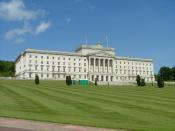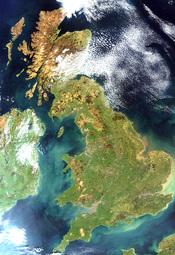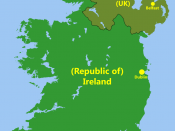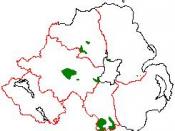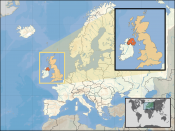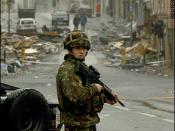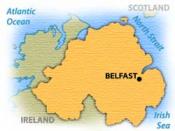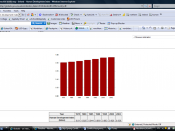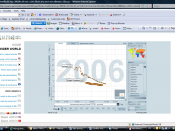World Issues Conflict Assignment: Northern Ireland Silja Spreng
Conflict Assignment: Northern Ireland
Location of the conflict
http://newsimg.bbc.co.uk/media/images/41788000/jpg/_41788164_uk_rep_ire_map203.jpg
http://www.flashpoints.info/CB-Northern%20Ireland.htm
Religion
In Northern Ireland there is basically a segregation of the population into two confessions: Catholic and protestant. In Northern Ireland there is a majority of Protestants from England and a catholic minority whereas in the Republic Ireland itself, there is a catholic majority versus a protestant minority.
The conflict has often been portrayed as a religious conflict but this is not correct: Religious differences have been used by political and religious leaders as a reason to justify the grouping of these people. But truly it is a conflict between the Unionist and Loyalists who seek to maintain a part of Great Britain and are usually Protestants versus the Nationalists and Republicans who are typically Catholic and see themselves as Irish.
Type of government(s)
There are three governments involved in the conflict: The government of England, the government of Northern Ireland and the government of the Republic of Ireland.
The Irish government is a parliamentary democracy consisting of two chambers, the House of Commons and the House of Lords, and a president. There is currently a coalition of three parties governing the country: Fianna Fail (conservative, Irish republicanism, economic liberalism), Progressive Democrats and Green Party.
Northern Ireland used to be administrated from the British government as a province of England, however, a coalition between the two parties, Sinn Fein and Democratic Unionist Party, which were originally hostile towards each other, was formed in 2007 and Northern Ireland now has its own parliamentary democratic government.
England is governed by a parliamentary system, it has a constitutional monarchy. The parliament consists of the House of Commons, the House of Lords, Prime Minister Gordon Brown and Head of State is Queen Elizabeth II. The three major parties in England are the Labour Party, the Conservative Party and the Liberal Democrats. The Labour Party has currently the majority in the parliament.
Environment
During the emergence of the conflict beginning with England taking over Northern Ireland as a province, arable land certainly played a role. However, in the continuance and towards the end of the conflict arable land was not of importance anymore. Fresh water was never of importance in this conflict.
Surrounding countries and their view on the situation and position in the world
Although the Northern Ireland conflict has been limited to the boarders of Northern Ireland, it received significant international attention and many other countries felt the need to interact in solving the conflict. The United States have been taking a great role in the peace making process, as being further outlined in question 4.
The Republic of Ireland had outlined the unification with Northern Ireland in their constitution. However, the Republic of Ireland abstains from this request due to the Good Friday Agreement and a referendum. But the agreement still keeps the opportunity of unification with Northern Ireland in case the majority of the Northern Irish population supports this.
Great Britain as a part of the conflict supports the Unionists and Loyalists and wants Northern Ireland to stay a part of the United Kingdom, however, it also advocated for a peaceful solution.
Human Development Index
The Human Development Index (HDI) looks beyond GDP to a broader definition of well-being and provides a composite measure of several aspects of life such as health, education, standard of living, etc.
There has not been a separate HDI just for Northern Ireland published; it is included in the HDI of the United Kingdom (England, Northern Ireland, Wales, and Scotland). Therefore we will look at the UK's and the Republic of Ireland's HDI.
According to the recent Human Development Report from 2007/2008, the HDI for the Republic of Ireland is 0.959, which gives the country a rank of 5th out of 177 countries.
Development of HDI in Ireland
According to the same data, the HDI for United Kingdom is 0.946, which gives the country a rank of 16th out of 177 countries.
Statistical graphs from www.gapminder.com
First of all, it has to be stated that Northern Ireland is not listed separately in Gapminder, therefore we will be looking at the data of the Republic of Ireland and the United Kingdom (England, Northern Ireland, Wales and Scotland).
Agriculture, contribution to economy (% of GDP) - Income per person
The huge decrease in contribution of agriculture to the economy from almost 20% of GDP in the 1970ies to just about 2% in recent years shows the economic development of the Republic of Ireland. There have been some fluctuations until 1994 due to the instability and conflicts in Northern Ireland which also affected the Republic of Ireland but from 1994 when the conflicts began to calm down and peace is being approached, the decrease is constant without fluctuations.
The graph of the United Kingdom is just a slightly downward sloping line because industrialization and economic development and therefore less agriculture have been introduced earlier than 1971 in the UK. In addition the possible fluctuations which could be seen in a graph for just Northern Ireland are being undermined by the data of England, Wales and Scotland.
CO2 emissions (tonnes per person) - Income per person
Noticing an increase in CO2 emissions from 1923 on with several fluctuations, it can be concluded that the Irish economy has been growing steadily. Again, there is a faster increase in CO2 emission in 1994 which shows the positive effects of peaceful approaches in the Northern Ireland conflict for the economy of the Republic of Ireland.
The United Kingdom's graph is again very straight from 1935 on due to the fact that possible fluctuations which could be seen in a graph for just Northern Ireland are being undermined by the data of England, Wales and Scotland.
Children per woman (total fertility) - Income per person
The huge decrease in children per woman (total fertility) between 1971 and 1994 again depicts the economic development of the Republic of Ireland because an increase in income tends to lead to fewer births because women get involved in jobs. The Republic of Ireland has build up its own economy, following the British model. From 1994 on the situation stabilized and the total fertility stayed constant.
In the UK, there is a decrease in total fertility from 1971 - 1975, followed by a period of time where it stays constant until 1992. Noticing a slight decrease from between 1993 and 2000, it finally starts to increase again.
A description paragraph of the conflict & timeline
The Northern Ireland conflict has a long history. The fights between the Catholics (descendants of Gaelic population, Eire) and Protestants (descendants of British colonists, Ulster) about religion, land and way of governing have been going on for a centuries and has killed thousands of people.
The Protestant Unionist community believes Northern Ireland should remain part of the UK, whereas the Catholic Nationalist community believes it should separate from the UK and become part of the Republic of Ireland.
From the 12th century on revolts and a civil war due to the brutal British rule of Ireland lead to a partition of the island (26 countries South ( Republic of Ireland; 6 stayed North with the UK ( Northern Ireland). The Catholic minority in Northern Ireland suffered discrimination.
From the 1970s lasting until the 1990s violence was a common way for paramilitary groups to achieve their goals. Attacks targeted civilians, police, soldiers and politicians.
In the early 1990s negotiations took place between political parties and the British and Irish governments. After long-winded negotiations IRA and loyalists declare ceasefire and "Good Friday" agreement was signed. It outlined a power-sharing executive, with ministerial posts distributed by party strength, and elected assembly. Population agreed with this in a referendum.
Timeline
1594-1603 | Rebellion in Ulster, overlaps to entire Ireland |
1608-1610 | Foundation of British settlement colony in Northern Ireland |
1641 | Beginning of Irish-Catholic rebellion - 1st rebellion of Irish had been fended off |
1649 | Arrival Cromwell's in Dublin - beginning of British recapture |
1652 | British Condemnation Laws - destruction of Irish middle and upper class |
1689 | Defeat of Catholic King James I. At the river Boyne - " Orange Day " |
1695 | Beginning of penal legislation against Catholics ( " Penal Laws " ) |
1782 | Irish parliament declares independence - protestant-Irish patriotism |
1795 | Foundation " Orange Order " - protestant, pro-British radicalism |
1800 | Abolishment of Irish sovereignty, unification with United Kingdom |
1823 | Foundation of " Catholic Association " - beginning of Catholicism |
1845-1848 | " Irish Famine " |
1870 | Movement pro Irish " Home Rule " |
1918-1921 | Irish fight for independence |
1921 | Signing treaty for independence of Ireland when separating from the North |
1926 | Formation of "Fianna Fail " und " Fine Gael " |
1949 | Irland becomes Republic |
1955 | Irland joins UNO |
1968 | Civil rights movement in NI - brutal protests |
1972 | "Bloody Sunday": British soldiers kill 14 pro-Irish protestors in Derry IRA does attacks to payback |
Following years | Several brutal attacks on both sides happen, many people being killed |
1993 | Premiers of Great Britain and Ireland sign "General agreement for peace" |
End 1994 | IRA declares cease-fire, pro-British Loyalists agree Official discussions between British government and Sinn Fein |
1995 | Irish-British framework plan for solution |
December 1995 | IRA declares refusal to give away weapons before signing a peace treaty |
06.1996 | Discussion with all parties in Belfast, US-senator George Mitchell is negotiating |
09.1997 | IRA calls for cease-fire, Sinn Fein participates in peace negotiations |
02.04.1998 | Population of Republic of Ireland and Northern Ireland vote for Good Friday Agreement in Belfast |
10.04.1998 | Protestants and Catholics sign peace treaty Creation of regional parliament, regional government Release of captives Cooperation of Northern Ireland and Republic of Ireland Parties promise total disarmament within 2 years |
25.06.1998 | Election for regional parliament |
In between | Still attacks and people killed |
10.09.1998 | First meeting between Gerry Adams (Sinn Fein) and David Trimble (UUP) |
16.10.1998 | Nobel prize for Peace for Unionist David Trimble and catholic nationalist John Hume |
Different point of views of the conflict
Description of side one's views
Pro - dependent on UK (Unionists' & Loyalists' point of view)
The Unionists and Loyalists, mostly Protestants, dominate Northern Ireland. They want Northern Ireland to stay a part of the United Kingdom. Important organizations in this side are for example the Ulster Union Party (UUP), the Democratic Unionists Party (DUP, protestant-unionists party), the Ulster Defence Association (UDA, most important of Protestant paramilitaries), the Ulster Freedom Fighter (UFF) and the Ulster Volunteer Force (UVF, second protestant paramilitary organization). The UUP and DUP are both responsible for a lot of street disorders and fights that caused many deaths, however, both parties deny this nowadays and refer to "little disorders". The UVF and UFF have committed many crimes killing civilizes in order to spread intimidation.
Description of side two's views
Contra - dependent on UK (Irish nationalists' point of view)
Description of side three's views
Republic of Ireland
The Republic of Ireland had outlined the unification with Northern Ireland in their constitution. However, the Republic of Ireland abstains from this request due to the Good Friday Agreement and a referendum. But the agreement still keeps the opportunity of unification with Northern Ireland in case the majority of the Northern Irish population supports this.
Involvement of the international community
Although the Northern Ireland conflict is the Northern Irish counterparts' very own conflict, it can certainly not be resolved by Northern Ireland on its own and international assistance is needed.
The European Union played an important role as a negotiator and financier of the change since 1973. The European Parliament took action in the 1980ies in favour of the minority in Northern Ireland by criticizing the behaviour of Great Britain and Ireland. The subsidies come from the European structural fund and from programs such as the "Peace and Reconciliation Programme".
The United States acted as well as a negotiator and financier on behalf of 40 million Americans of Irish decent. Bill Clinton visited the conflict area in 1995 and on April, 10th 1997 the US special envoy George Mitchell and the British Northern Ireland minister Marjorie Mowlan ended the conflict after long negotiations with a peace agreement. However, the peace process turned out to be very long-winded and finally the Good Friday Agreement has been passed in 1998. It outlined the rejection of violence and resolution of the conflict in peace.
NATO has not been involved in the Northern Ireland conflict.
Canada's view on the issue
Canada has a very good relationship with Great Britain; it is a member of the Common Wealth and still honours Queen Elizabeth II as its Head of State. Due to this historic tie, a loyalty towards Great Britain exists and therefore Canada is not only advocating for a peaceful solution but also supporting Great Britain's point of views.
Canada has been a supporter of the Northern Ireland Peace Process and the Good Friday Agreement which provides a guideline for the devolution of government in Northern Ireland. As part of its support, Canada has contributed more than $7.7 million to the International Fund for Ireland since its inception in 1986. The fund is used to foster mutual understanding and reconciliation between community groups from different traditions in Northern Ireland.
In March 2007, Prime Minister Stephen Harper welcomed the new power-sharing arrangement in Northern Ireland and stated: "I congratulate the leaders of the Democratic Unionist Party (DUP) and Sinn Féin political party in Northern Ireland for their determination to seize this historic opportunity. This outcome represents the beginning of a new and welcome era for the people of Northern Ireland. The Governments of the United Kingdom and Ireland also deserve credit for their steadfast efforts towards this end."
References
Flashpoints: http://www.flashpoints.info/CB-Northern%20Ireland.htm
HDR Stats: http://hdrstats.undp.org/countries/country_fact_sheets/cty_fs_IRL.html
http://hdrstats.undp.org/countries/country_fact_sheets/cty_fs_GBR.html
http://globalis.gvu.unu.edu/indicator_detail.cfm?IndicatorID=15&Country=IE
Prime Minister (Stephen Harper): http://www.pm.gc.ca/includes/send_friend_eMail_print.asp?id=1598
BBC: http://www.bbc.co.uk/history/recent/troubles/
http://news.bbc.co.uk/2/hi/uk_news/northern_ireland/4072261.stm
United Nations: http://www.un.org/News/Press/docs/2006/ga10508.doc.htm
Time line: http://www.historyonthenet.com/Chronology/timelinenorthernireland.htm
� PAGE \* MERGEFORMAT �1����
